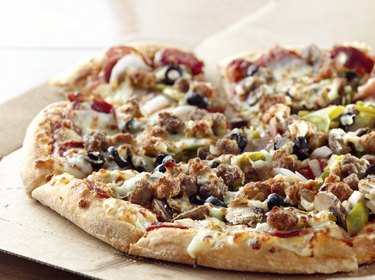
Unless the delivery is slow and you're already at the table with knife and fork at hand, chances are you'll need to occasionally keep a pizza warm, in the oven or out, until it's time to eat. Although it's simple enough to maintain a high temperature, keeping the pizza at its best is more problematic. If you expose it to too much heat it can become dry and unappetizing, while trapping too much moisture can leave the crust and toppings soggy. The best techniques avoid both extremes.
Keep Pizza Warm in the Oven
Video of the Day
Step 1
Preheat your oven to 200 degrees Fahrenheit when you place your order. This provides opportunity for the oven's interior to become thoroughly warmed while you await the pizza's arrival.
Video of the Day
Step 2
Open the pizza briefly as soon as it arrives, to let out the steam that has accumulated while the pizza was held within its insulated delivery bag, then re-close the box.
Step 3
Locate the cutout vents that are stamped into most pizza boxes. If they're not currently open, punch them out with your thumb or the handle of a wooden spoon. This prevents further steam from building up.
Step 4
Slide the pizza box into your oven and reduce the heat to your oven's lowest setting, ideally no more than 140 or 150 degrees Fahrenheit.
The No-Box Oven Method
Step 1
Preheat a stoneware pizza "stone" in your oven at 200 F, for at least 30 to 45 minutes. This provides ample time for the stone's dense material to absorb and store the oven's heat.
Step 2
Open the pizza box as soon as the pie arrives. Unfold one end of the box, and slide the pizza directly from the box onto your pizza stone.
Step 3
Cover the pizza loosely with a square of aluminum foil, tucking it under the stone at two corners but leaving it loose at the remaining two so steam can escape.
Step 4
Close the oven door and reduce its temperature to the lowest available setting. A temperature of 140 to 150 F is ideal, hot enough for food safety and palatability but too low to dry or overcook the pizza.
Step 5
Keep the pizza warm in your oven for no more than one to two hours, for the best possible quality. After more than two hours, the crust will begin to dry out.
The "Wrap" Method
Step 1
Open the box as soon as you receive your pizza, to let out the steam that accumulates during delivery. That steam dampens the box and is responsible for the "cardboard" flavor that often mars delivery pizza.
Step 2
Close the box again and locate the vents that are stamped into most pizza boxes. Punch them out with a utensil or thumbnail to prevent further steam buildup. If your box has no pre-cut vents, cut several small holes of your own in the corners of the box with a paring knife.
Step 3
Place the box on a heavy bath towel or small blanket. Fold the sides of the towel or blanket, so they completely cover the box. For a heavier layer of insulation, lay two towels across each other at right angles and fold them over the top.
Step 4
Serve and eat the pizza within 30 minutes for the best quality, though it can remain reasonably warm for up to an hour if you've doubled the wrapper.
Tip
For individual-sized pizzas of 10 inches or less, use the stoneware tortilla warmers sold in many kitchenware stores. Preheat the stoneware in a warm oven, then slide the pizza into the warmer and replace the lid. The unglazed stoneware absorbs enough steam to prevent the pizza from becoming soggy but retains enough moisture to prevent drying.
If you don't have a pizza stone but want to avoid the risk of box-flavored pizza, place a small cooling rack on a baking sheet and slide the pizza onto the rack. Cover the sheet loosely with foil, and slide your pizza into the oven.
If your pizza is in the oven for more than an hour, place a cup of boiling water on a lower shelf for five minutes. The increased moisture within the oven will help prevent your pizza from drying out, but isn't enough to make it soggy.
Your pizza will remain perfectly edible if it's kept in the box for longer than 30 minutes, but the longer it's held the likelier it is to acquire that distinctive pizza-box flavor from the cardboard.
Warning
Keeping your pizza warm isn't just a matter of preference, it's also necessary for food safety. Hot foods must be held at a temperature of 140 F or higher to deter the growth of potentially dangerous bacteria, or pathogens. Like any other perishable food, pizza should not be left on the counter for longer than 2 hours at room temperature.